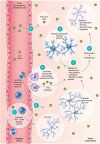Molecular neuroimaging of inflammation in HIV
- PMID: 35020855
- PMCID: PMC9585552
- DOI: 10.1093/cei/uxab013
Molecular neuroimaging of inflammation in HIV
Abstract
People with HIV now have near-normal life expectancies due to the success of effective combination antiretroviral therapy (cART). Following cART initiation, immune recovery occurs, and opportunistic diseases become rare. Despite this, high rates of non-infectious comorbidities persist in treated people with HIV, hypothesized to be related to persistent immuno-activation. One such comorbidity is cognitive impairment, which may partly be driven by ongoing neuro-inflammation in otherwise effectively treated people with HIV. In order to develop therapeutic interventions to address neuro-inflammation in effectively treated people with HIV, a deeper understanding of the pathogenic mechanisms driving persistent neuro-inflammatory responses and the ability to better characterize and measure neuro-inflammation in the central nervous system is required. This review highlights recent advances in molecular neuroimaging techniques which have the potential to assess neuro-inflammatory responses within the central nervous system in HIV disease. Proton magnetic resonance spectroscopy (1H-MRS) has been utilized to assess neuro-inflammatory responses since early in the HIV pandemic and shows promise in recent studies assessing different antiretroviral regimens. 1H-MRS is widely available in both resource-rich and some resource-constrained settings and is relatively inexpensive. Brain positron emission tomography (PET) imaging using Translocator Protein (TSPO) radioligands is a rapidly evolving field; newer TSPO-radioligands have lower signal-to-noise ratio and have the potential to localize neuro-inflammation within the brain in people with HIV. As HIV therapeutics evolve, people with HIV continue to age and develop age-related comorbidities including cognitive disorders. The use of novel neuroimaging modalities in the field is likely to advance in order to rapidly assess novel therapeutic interventions and may play a role in future clinical assessments.
Keywords: human; immunodeficiency diseases; inflammation; viral.
© The Author(s) 2021. Published by Oxford University Press on behalf of the British Society for Immunology.
Figures





References
-
- Deeks SG, Overbaugh J, Phillips A, Buchbinder S.. HIV infection. Nat Rev Dis Primers 2015, 1, 15035. - PubMed
-
- Global HIV & AIDS Statistics — 2020 Fact Sheet | UNAIDS . https://www.unaids.org/en/resources/fact-sheet (10 April 2021, date last accessed).
-
- Vergis EN, Mellors JW.. Natural history of HIV-1 infection. Infect Dis Clin North Am 2000, 14, 809–25, v–vi. - PubMed
-
- Cooper DA, Gold J, Maclean P, et al.. Acute AIDS retrovirus infection. Definition of a clinical illness associated with seroconversion. Lancet 1985, 1, 537–40. - PubMed
Publication types
MeSH terms
Substances
LinkOut - more resources
Full Text Sources
Medical
Research Materials

